Log in
Search
Latest topics
» My N-1R build logby roddie Today at 12:32 am
» Happy 77th birthday Andrew!
by akjgardner Today at 12:27 am
» TEE DEE Having issues
by TD ABUSER Yesterday at 9:43 pm
» Landing-gear tips
by roddie Yesterday at 6:17 pm
» Roger Harris revisited
by TD ABUSER Yesterday at 2:13 pm
» Tee Dee .020 combat model
by Ken Cook Yesterday at 1:41 pm
» Retail price mark-up.. how much is enough?
by Ken Cook Yesterday at 1:37 pm
» My latest doodle...
by roddie Yesterday at 10:43 am
» Chocolate chip cookie dough.........
by roddie Fri Nov 22, 2024 1:13 pm
» Purchased the last of any bult engines from Ken Enya
by sosam117 Fri Nov 22, 2024 11:32 am
» Free Flight Radio Assist
by rdw777 Fri Nov 22, 2024 9:24 am
» Funny what you find when you go looking
by rsv1cox Wed Nov 20, 2024 3:21 pm
Cox Engine of The Month
Profile P-39, what do you think? A nip here a tuck there........
Page 1 of 1
 Profile P-39, what do you think? A nip here a tuck there........
Profile P-39, what do you think? A nip here a tuck there........
CG a problem?
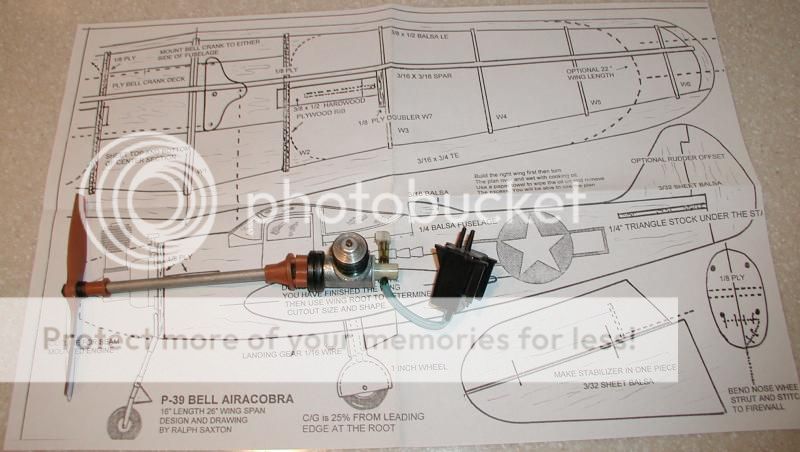
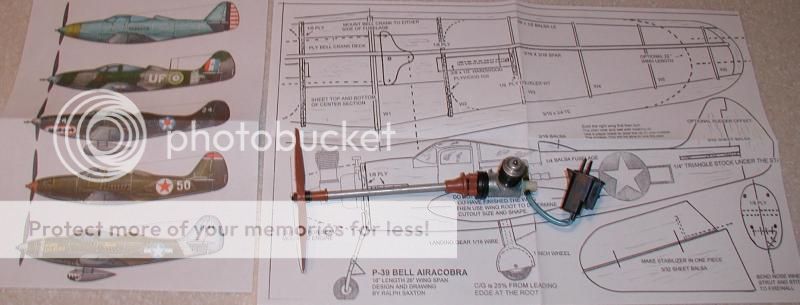
I think this would be a neat build. Engine out of a BD-5 pusher. I would probably have to re-prop.


I think this would be a neat build. Engine out of a BD-5 pusher. I would probably have to re-prop.

rsv1cox- Top Poster




Posts : 11250
Join date : 2014-08-18
Location : West Virginia
 Re: Profile P-39, what do you think? A nip here a tuck there........
Re: Profile P-39, what do you think? A nip here a tuck there........
Mid engine installation, I like it, I'd say go for it! 


GallopingGhostler- Top Poster


Posts : 5724
Join date : 2013-07-13
Age : 70
Location : Clovis NM or NFL KC Chiefs
 Re: Profile P-39, what do you think? A nip here a tuck there........
Re: Profile P-39, what do you think? A nip here a tuck there........
Thinking about the down thrust angle. Hang the cylinder out on the outside of the fuse, but it would be nice to figure out a vertical installation. "Product" engine. No screw holes, would have to mount it fixed on rails. Nothing that couldn't be solved.

rsv1cox- Top Poster




Posts : 11250
Join date : 2014-08-18
Location : West Virginia
 Re: Profile P-39, what do you think? A nip here a tuck there........
Re: Profile P-39, what do you think? A nip here a tuck there........
For CL, downthrust is unnecessary.
Since right thrust is impractical, to keep lines taught, some outboard wing tip weight and rudder canted toward outside the circle should maintain line tension.
Sounds like an exciting project and will be able to turn heads at the circle.
That's what my Estes Y-Wing fighter needs to get rid of the 2 oz. lead weight in the nose.
Since right thrust is impractical, to keep lines taught, some outboard wing tip weight and rudder canted toward outside the circle should maintain line tension.
Sounds like an exciting project and will be able to turn heads at the circle.
That's what my Estes Y-Wing fighter needs to get rid of the 2 oz. lead weight in the nose.


GallopingGhostler- Top Poster


Posts : 5724
Join date : 2013-07-13
Age : 70
Location : Clovis NM or NFL KC Chiefs
 Re: Profile P-39, what do you think? A nip here a tuck there........
Re: Profile P-39, what do you think? A nip here a tuck there........
To overcome the need for right thrust (which would be near impossible to achieve with that set-up) I'd suggest running a left hand prop clockwise, so the original Testors prop could work. Apparently the clockwise thrust will naturally tend to roll the plane outboard. Some down thrust might help to keep the light nose down, but in all practicality I would suggest you'll need nose weight.

Oldenginerod- Top Poster

- Posts : 4018
Join date : 2012-06-15
Age : 62
Location : Drouin, Victoria
 Re: Profile P-39, what do you think? A nip here a tuck there........
Re: Profile P-39, what do you think? A nip here a tuck there........
You might still need a slight amount of outboard wingtip weight. Torque roll and propwash aren't the only things tip weight is used to counter. The weight of the lines and their drag is part of it too. In stunt plane design, some builders start with matching the weight of the lines and adjusting from there. I know with 1/2A it's not like 60' of steel wire, but still maybe a small consideration.
You can still build in some outboard thrust. A tiny offset at the engine makes a significant amount at the prop.
Rusty
You can still build in some outboard thrust. A tiny offset at the engine makes a significant amount at the prop.
Rusty
_________________
Don't Panic!
...and never Ever think about how good you are at something...
while you're doing it!
My Hot Rock & Blues Playlist
...and never Ever think about how good you are at something...
while you're doing it!
My Hot Rock & Blues Playlist

RknRusty- Rest In Peace

- Posts : 10869
Join date : 2011-08-10
Age : 68
Location : South Carolina, USA
 Re: Profile P-39, what do you think? A nip here a tuck there........
Re: Profile P-39, what do you think? A nip here a tuck there........
Hey Bob.. cool beans!!! I think you could manage to offset the CG of a mid-engine.. by designing a functional nose-block/cowling for the prop-end of the shaft/sleeve to run in. Make it like a vertical 2-piece "pillow-block" that screws together top and bottom. This would support the necessary horizontal-split in a profile nose-plank for the shaft to run through. You could then either leave the rest of the shaft exposed.. or cover it with 1/16" sheet balsa doublers; back to the engine coupling.
Maybe design a beam-mount with enough clearance behind the engine, to be able to slide the engine back to disengage that 4-pin coupling if the engine needs servicing.
Maybe design a beam-mount with enough clearance behind the engine, to be able to slide the engine back to disengage that 4-pin coupling if the engine needs servicing.
 Re: Profile P-39, what do you think? A nip here a tuck there........
Re: Profile P-39, what do you think? A nip here a tuck there........
I know some will disagree, but I think that right thrust isn't as big of a deal. There was considerable discussion of the topic in Brotherhood of the Ring. One old time prolific flier, Dennis Lipsett brought up an interesting issue. Yes, one can fly without right thrust.
I've flown without right thrust on my Ringmaster S-1 and on Half-A's, too. If you look at the Scientific designs by Walt Musciano and at the Sterling Beginner series, you won't see right thrust. Those designs particularly sandwich the landing gear behind the engine and firewall lack it.
Do all? No, but a good number do.
Torque of the prop tends to roll the aircraft to the left which in turn tends to induce left banking. Tip weight helps to counter this. Additonal tip weight also overcomes the weight of the lines. Speed of the aircraft to create centripetal force in the circle helps, too.
I'd say a more important point besides healthy right rudder is location of the left wing tip guide to be slightly aft, which causes the aircraft to point slightly out. This has an effect of outward thrust.
Is right thrust a bad practice? No. Of course it makes sense and normally two washers under the left engine rear helps, because the distance between prop and rear mounting holes is relatively short. Here in this case the engine has a very long shaft, any useful thrust angle will be hard to achieve.
Anyway, I wish rsv1cox the best of luck, you've got an interesting project that I'm sure will work out fine.
I've flown without right thrust on my Ringmaster S-1 and on Half-A's, too. If you look at the Scientific designs by Walt Musciano and at the Sterling Beginner series, you won't see right thrust. Those designs particularly sandwich the landing gear behind the engine and firewall lack it.
Do all? No, but a good number do.
Torque of the prop tends to roll the aircraft to the left which in turn tends to induce left banking. Tip weight helps to counter this. Additonal tip weight also overcomes the weight of the lines. Speed of the aircraft to create centripetal force in the circle helps, too.
I'd say a more important point besides healthy right rudder is location of the left wing tip guide to be slightly aft, which causes the aircraft to point slightly out. This has an effect of outward thrust.
Is right thrust a bad practice? No. Of course it makes sense and normally two washers under the left engine rear helps, because the distance between prop and rear mounting holes is relatively short. Here in this case the engine has a very long shaft, any useful thrust angle will be hard to achieve.
Anyway, I wish rsv1cox the best of luck, you've got an interesting project that I'm sure will work out fine.

GallopingGhostler- Top Poster


Posts : 5724
Join date : 2013-07-13
Age : 70
Location : Clovis NM or NFL KC Chiefs
 Re: Profile P-39, what do you think? A nip here a tuck there........
Re: Profile P-39, what do you think? A nip here a tuck there........
GallopingGhostler wrote:I know some will disagree, but I think that right thrust isn't as big of a deal. There was considerable discussion of the topic in Brotherhood of the Ring. One old time prolific flier, Dennis Lipsett brought up an interesting issue. Yes, one can fly without right thrust.
I've flown without right thrust on my Ringmaster S-1 and on Half-A's, too. If you look at the Scientific designs by Walt Musciano and at the Sterling Beginner series, you won't see right thrust. Those designs particularly sandwich the landing gear behind the engine and firewall lack it.
Do all? No, but a good number do.
Torque of the prop tends to roll the aircraft to the left which in turn tends to induce left banking. Tip weight helps to counter this. Additonal tip weight also overcomes the weight of the lines. Speed of the aircraft to create centripetal force in the circle helps, too.
I'd say a more important point besides healthy right rudder is location of the left wing tip guide to be slightly aft, which causes the aircraft to point slightly out. This has an effect of outward thrust.
Is right thrust a bad practice? No. Of course it makes sense and normally two washers under the left engine rear helps, because the distance between prop and rear mounting holes is relatively short. Here in this case the engine has a very long shaft, any useful thrust angle will be hard to achieve.
Anyway, I wish rsv1cox the best of luck, you've got an interesting project that I'm sure will work out fine.
George,
I disagree...

In level flight I don't think engine offset has a huge effect. However, you will notice it when you force the plane into a sharp maneuver and the air speed bleeds off. Also you will notice it in the overheads especially. That said rudder offset is rarely used anymore and has a tendancy to cause excessive yaw which creates drag thus slowing you down in maneuvers.
I still use rudder offset when I am having tension problems on some airframes. Even then it is minimal.
I also try and keep tipweight to a minimum to prevent hinging. Where you fly the wind plays a large roll and I noticed you guys that way use a fair amount to keep the outboard wing from lifting on the windward side.
Then there are planes like the Bi-Slob that use a tremendous amount of both to keep tension when hovering. In speed planes no engine offset or rudder offset is used and it is a bear to keep line tension until speed picks up.
Anyway, if I was to abandon one it would be rudder offset and not engine offset.
Ron

Cribbs74- Moderator



Posts : 11907
Join date : 2011-10-24
Age : 50
Location : Tuttle, OK
 Re: Profile P-39, what do you think? A nip here a tuck there........
Re: Profile P-39, what do you think? A nip here a tuck there........
Centrifugal force is your best bet for line tension, remember combat planes have no rudder and a well trimmed stunt ship needs very little engine offset, but i do like a little off set...and a little tail is always good!
On this build i don't think off set is critical, but could be built in easy.
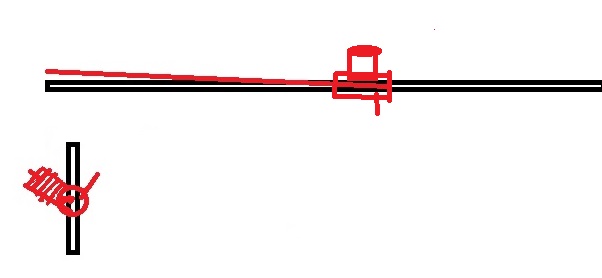
I'd grab that yellow Cox spinner you have and use that along with a Cox three blade prop if thats the right rotation, or a Cox Corsair LH prop? Also if you look at the plans the nose is a little non-scale short would be easy to extent it a little and add to the scale lines.
I'm sure a club member built a p-39 recently for the Speed race?

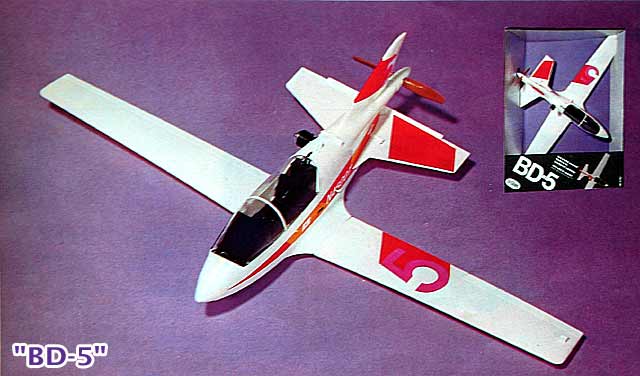
On this build i don't think off set is critical, but could be built in easy.

I'd grab that yellow Cox spinner you have and use that along with a Cox three blade prop if thats the right rotation, or a Cox Corsair LH prop? Also if you look at the plans the nose is a little non-scale short would be easy to extent it a little and add to the scale lines.
I'm sure a club member built a p-39 recently for the Speed race?


 Re: Profile P-39, what do you think? A nip here a tuck there........
Re: Profile P-39, what do you think? A nip here a tuck there........
Mark Boesen wrote:
I'm sure a club member built a p-39 recently for the Speed race?
Yeah, what ever happened to that? That was one cool looking plane, but I don't remember who's it was aand we never saw it again. I can't find the picture. It would be good to hear from the builder about how he went for balance and whether it ever flew.
Come to think of it, there were a lot of pictures of nice reed speed planes posted which we never saw again. How many contestants actually got in a recordable flight?

Rod.

Oldenginerod- Top Poster

- Posts : 4018
Join date : 2012-06-15
Age : 62
Location : Drouin, Victoria
 Re: Profile P-39, what do you think? A nip here a tuck there........
Re: Profile P-39, what do you think? A nip here a tuck there........
If I was to make it (and I've had the same idea but in full fuselage like a Consolidated model) I'd set the motor up sidewinder with the cylinder outboard, and the shaft and prop dead straight. C/L models fly with a tangent to the outboard of the circle and fly in a slip, so tip weight is all that is needed and slipstream effect is only a problem on launch with a top mounted fin. No rudder offset either. I'd reduce the wing thickness to a third of what is shown, lower it to the bottom of the fuse and add dihedral, and redraw the side view to a perfect scale shape, no need for that tubby rendition when the original was so well done. I'd bury the controls inside and use cable for the leadouts, and it'd be a good little Stunter, for basics anyway.
For a speed ship it'd never go fast. Might as well make it pretty and fly well. Cobra II or KF-1 paint scheme, it'd be gorgeous.
Chris...
For a speed ship it'd never go fast. Might as well make it pretty and fly well. Cobra II or KF-1 paint scheme, it'd be gorgeous.
Chris...
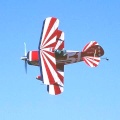
stuntflyr- Gold Member

- Posts : 266
Join date : 2012-01-18
Age : 65
Location : Tucson, Arizona
 Re: Profile P-39, what do you think? A nip here a tuck there........
Re: Profile P-39, what do you think? A nip here a tuck there........
I've never really understood the purpose of dihedral on a C/L plane. If it's built with the leadouts parallel to the plane of the wing, any flight above arm height will tend to pull the inboard tip down, causing it to potentially roll in. I would have thought that if dihedral was used then the leadouts would have to be beneath the wing and the guide extended lower than the bellcrank.stuntflyr wrote:I'd reduce the wing thickness to a third of what is shown, lower it to the bottom of the fuse and add dihedral,
I have no experience of this in practice, but had always wondered. I have a SIG Dewey Bird kit to build and I've been unwilling to build it until I can get my head around the dihedral thing. I always though dihedral was to give stability to the plane when flying straight, which is clearly not an issue in C/L. In contrast, my late brother's (full size) Luton Minor had absolutely no dihedral and was extremely stable.

Rod.

Oldenginerod- Top Poster

- Posts : 4018
Join date : 2012-06-15
Age : 62
Location : Drouin, Victoria
 Re: Profile P-39, what do you think? A nip here a tuck there........
Re: Profile P-39, what do you think? A nip here a tuck there........
Oldenginerod wrote:Mark Boesen wrote:
I'm sure a club member built a p-39 recently for the Speed race?
Yeah, what ever happened to that? That was one cool looking plane, but I don't remember who's it was and we never saw it again. I can't find the picture.
Here it is!

Still no idea of the builder. Are you out there?

Oldenginerod- Top Poster

- Posts : 4018
Join date : 2012-06-15
Age : 62
Location : Drouin, Victoria
 Re: Profile P-39, what do you think? A nip here a tuck there........
Re: Profile P-39, what do you think? A nip here a tuck there........
Wow, Lot's to think about here. Maybe I should just farm this project out to someone more qualified...  . Nope, I'm going to give it a go using your suggestions and insights.
. Nope, I'm going to give it a go using your suggestions and insights.
About the only thing I don't have is the 1/4" balsa sheet for the fuselage and that's available at the LHS.
Prop shaft balance and alignment may be a problem. I like the two piece "pillow" concept for containing the forward prop shaft bushing. Mounting the engine securely for me presents the greatest difficulty, there is just nothing on the engine to secure it with other than a single rib on one side.
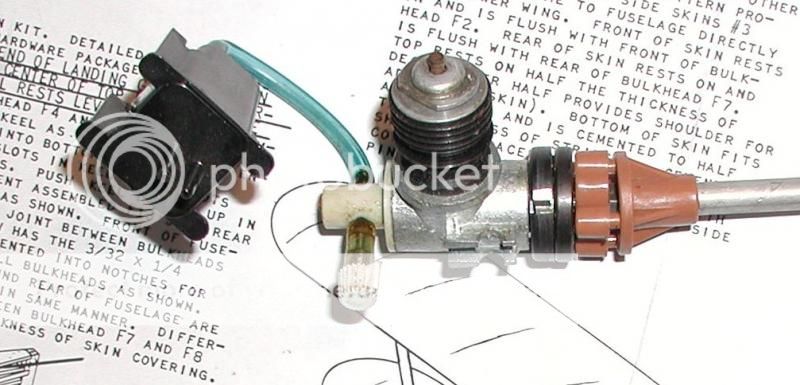
Looking at that BD-5 (Thanks Mark) and the position of the engine and gas tank well back of the CG makes you wonder how it ever flew. I would guess the generous area of the horizontal stab and engine alignment had a lot to do with it. This P-39 out to be a piece of cake to balance.
I hope the builder of that Cox powered P-39 chimes in. I would like to see how he did the shaft drive. A picture of the other side would be nice.
About the only thing I don't have is the 1/4" balsa sheet for the fuselage and that's available at the LHS.
Prop shaft balance and alignment may be a problem. I like the two piece "pillow" concept for containing the forward prop shaft bushing. Mounting the engine securely for me presents the greatest difficulty, there is just nothing on the engine to secure it with other than a single rib on one side.

Looking at that BD-5 (Thanks Mark) and the position of the engine and gas tank well back of the CG makes you wonder how it ever flew. I would guess the generous area of the horizontal stab and engine alignment had a lot to do with it. This P-39 out to be a piece of cake to balance.
I hope the builder of that Cox powered P-39 chimes in. I would like to see how he did the shaft drive. A picture of the other side would be nice.
Last edited by rsv1cox on Wed Jan 14, 2015 9:32 am; edited 1 time in total

rsv1cox- Top Poster




Posts : 11250
Join date : 2014-08-18
Location : West Virginia
 Re: Profile P-39, what do you think? A nip here a tuck there........
Re: Profile P-39, what do you think? A nip here a tuck there........
Rod that plane is so unique that he probably didn't fly it after see planes made into kindling////// RKflyer that was his plane ,,,in this thread you can see all the old entries . Eric  Scroll Down Go Back Sideways
Scroll Down Go Back Sideways 
https://www.coxengineforum.com/t6515p60-reed-speed-qualifying-photos-post-em-if-ya-got-em?highlight=reed+speed

https://www.coxengineforum.com/t6515p60-reed-speed-qualifying-photos-post-em-if-ya-got-em?highlight=reed+speed

getback- Top Poster



Posts : 10442
Join date : 2013-01-18
Age : 67
Location : julian , NC
 Re: Profile P-39, what do you think? A nip here a tuck there........
Re: Profile P-39, what do you think? A nip here a tuck there........
Bob , PM rkflyer I don't think he would mine and mite be better than just hoping ?? Getback 


getback- Top Poster



Posts : 10442
Join date : 2013-01-18
Age : 67
Location : julian , NC
 Re: Profile P-39, what do you think? A nip here a tuck there........
Re: Profile P-39, what do you think? A nip here a tuck there........
getback wrote:Bob , PM rkflyer I don't think he would mine and mite be better than just hoping ?? Getback
Thanks Eric, I just looked at that link. Interesting and will-do.
Bob

rsv1cox- Top Poster




Posts : 11250
Join date : 2014-08-18
Location : West Virginia
 P-39 Air cobra
P-39 Air cobra
I am glad to see more interest in the mid engine design & the Air Cobra. To ans. your question, I never flew the plane because I had no one to film it & I didn't want to crash it without some film!!
In my pictures I tried to show some of the things I did to mount the engine & the test mount I ran the engine on. Its actually not hard to do and I have since found a source for parts. Go to : www.dumasproducts.com Look under boat parts for shaft & stuffing box I used the universal No. 2905 for the shaft.
I am going to go back to my original project, "The Stiletto" which was a speed plane built by Richard LaConte and I think the first to try the mid engine design.
The prototype plane did 64-68 mph with a Cox 049 Space Hopper but crashed after a few flights. The Stiletto was built after the prototype crashed and it has a 049 Tee Dee for power,a bladder type fuel tank, a built up fuse with the engine located mid fuse & is inverted with just the glow plug showing below the wing. This one did 71-78 mph but it also crashed which really makes me wonder if I can even fly it!!
The Stiletto is a great looking plane, it just LOOKS FAST & the plans comes with all the info on the speed plane that was built by Richard La Conte. If you would like more info just send me a PM, RK FLYER
In my pictures I tried to show some of the things I did to mount the engine & the test mount I ran the engine on. Its actually not hard to do and I have since found a source for parts. Go to : www.dumasproducts.com Look under boat parts for shaft & stuffing box I used the universal No. 2905 for the shaft.
I am going to go back to my original project, "The Stiletto" which was a speed plane built by Richard LaConte and I think the first to try the mid engine design.
The prototype plane did 64-68 mph with a Cox 049 Space Hopper but crashed after a few flights. The Stiletto was built after the prototype crashed and it has a 049 Tee Dee for power,a bladder type fuel tank, a built up fuse with the engine located mid fuse & is inverted with just the glow plug showing below the wing. This one did 71-78 mph but it also crashed which really makes me wonder if I can even fly it!!
The Stiletto is a great looking plane, it just LOOKS FAST & the plans comes with all the info on the speed plane that was built by Richard La Conte. If you would like more info just send me a PM, RK FLYER


RK Flyer- Gold Member

- Posts : 274
Join date : 2013-07-16
Location : Somerset, Kentucky
 Re: Profile P-39, what do you think? A nip here a tuck there........
Re: Profile P-39, what do you think? A nip here a tuck there........
Oldenginerod wrote:I've never really understood the purpose of dihedral on a C/L plane. If it's built with the leadouts parallel to the plane of the wing, any flight above arm height will tend to pull the inboard tip down, causing it to potentially roll in. I would have thought that if dihedral was used then the leadouts would have to be beneath the wing and the guide extended lower than the bellcrank.stuntflyr wrote:I'd reduce the wing thickness to a third of what is shown, lower it to the bottom of the fuse and add dihedral,
I have no experience of this in practice, but had always wondered. I have a SIG Dewey Bird kit to build and I've been unwilling to build it until I can get my head around the dihedral thing. I always though dihedral was to give stability to the plane when flying straight, which is clearly not an issue in C/L. In contrast, my late brother's (full size) Luton Minor had absolutely no dihedral and was extremely stable.
Rod.
Hi Rod,
Your assumption about the "plane of the leadouts" rolling the model inboard is incorrect.
The reason for CL models having dihedral is to make it look like the airplane being modeled. The tips being close to the vertical CG of the model make it so the controls can be completely enclosed and the leadouts exit the wing at the tip. This makes it clean and squarely well engineered for proper flight.
The leadout position as it leaves the leadout guide is the place where the forces are subjected on the model. Therefore the proper height and fore/aft location are the critical point. These are validated from way back in CL Scale designs, the writings of Bill Netzeband in his famous Round&Round column in MAN, and scale-like Stunt designs such as Al Rabe's celebrated Mustang, Bearcat and Sea Fury Stunters all with dihedral and internal controls exiting the properly designed height on the models CG and adjustable fore/aft sliders in the wingtip.
If one is building a model for Stunt, Speed or Racing, no dihedral would be needed. Since this model would be of a particular Bell design, making it scale and flyable would be the way to make it look most like the prototype and fly well as a CL model.
The plan on which the engine is laid out on RSV's original post's pictured is a neat little design, it isn't very Scale though. I would say that it would be a great little 1/2A Stunter as desgned. Since the aspect of a mid-engine was introduced the non-scale stunt wing is a hinderence to that design's layout, I proposed my suggestions. RSV can do as he thinks is best of course and I look forward to his progress in a very inresting endevour.
Chris...

stuntflyr- Gold Member

- Posts : 266
Join date : 2012-01-18
Age : 65
Location : Tucson, Arizona
 Re: Profile P-39, what do you think? A nip here a tuck there........
Re: Profile P-39, what do you think? A nip here a tuck there........
stuntflyr wrote:Oldenginerod wrote:I've never really understood the purpose of dihedral on a C/L plane. If it's built with the leadouts parallel to the plane of the wing, any flight above arm height will tend to pull the inboard tip down, causing it to potentially roll in. I would have thought that if dihedral was used then the leadouts would have to be beneath the wing and the guide extended lower than the bellcrank.stuntflyr wrote:I'd reduce the wing thickness to a third of what is shown, lower it to the bottom of the fuse and add dihedral,
I have no experience of this in practice, but had always wondered. I have a SIG Dewey Bird kit to build and I've been unwilling to build it until I can get my head around the dihedral thing. I always though dihedral was to give stability to the plane when flying straight, which is clearly not an issue in C/L. In contrast, my late brother's (full size) Luton Minor had absolutely no dihedral and was extremely stable.
Rod.
Hi Rod,
Your assumption about the "plane of the leadouts" rolling the model inboard is incorrect.
Chris. I'm not questioning the reason for dihedral, which, by your explaination, is mainly used for looks in CL aircraft. In my vague understanding of physics, I would think that line tension is going to want to keep the lines straight, this pulling the inboard tip lower. If you consider that the thrust line is going to make the leadouts between the wing tip and the bellcrank run parallel to the lines, then the thrust line will exit the outboard side of the plane well below the wing tip, wheras with a straight wing the thrust line would exit the opposite wing tip.
Just my theories. In practical thinking, I can't help thinking that pulling the inner tip down will require further compensation with outer tip weight.

Oldenginerod- Top Poster

- Posts : 4018
Join date : 2012-06-15
Age : 62
Location : Drouin, Victoria
 Re: Profile P-39, what do you think? A nip here a tuck there........
Re: Profile P-39, what do you think? A nip here a tuck there........
The forces just act on the point where the leadout exits the wing or leadout guide. Low wing models need the leadouts higher than the wing (if it was straight) and high wing designs need it lower. If the model has the dihedral so that the height of the wingtip is proper for the vertical CG, you can run the leadouts out of the wingtip.
Here is a photo of my Tigercat leadouts. I just guessed at their proper height after considering the high winged model would need the leadouts low on the models total vertical mass. I installed the ply guide with a lot of area so I could move it. I was informed the model actually was rolled out a bit so raised them up and found the right height.
In the case of positive dihedral with leadouts internally, consider the mass of the model higher than the position of the leadouts at their exit, and that mass is balancing against the (very little) roll moment of the leadout to bellcrank misalignment. Raise and lower the leadout guide, even within the wingtip and see an attitude change while inflight. This is how it reacts in tethered flight like CL. Wingtip weight seems to be the same as a similar sized straight winged model.
I'm building a Top Flight Mustang with scale dihedral and will run the controls internally just as designed. I'll have photos and flying reports as soon as I fly it, but since it was designed by Stunt and Scale champion Jerry Worth and produced a few winning models by modelers all through the 60's, 70's and up until now, I'm figuring it'll be pretty close to right on with regard to wings level attitude. I believe the P-51 is just about right in this regard, and was the reason Al Rabe started his scale-like Stunters with that design. Check out his videos on You Tube to see them in action, nothing like a visual to help one figure it all out. It is with me, anyway.
Chris...
https://www.youtube.com/watch?v=RbzKY3Y3iLc
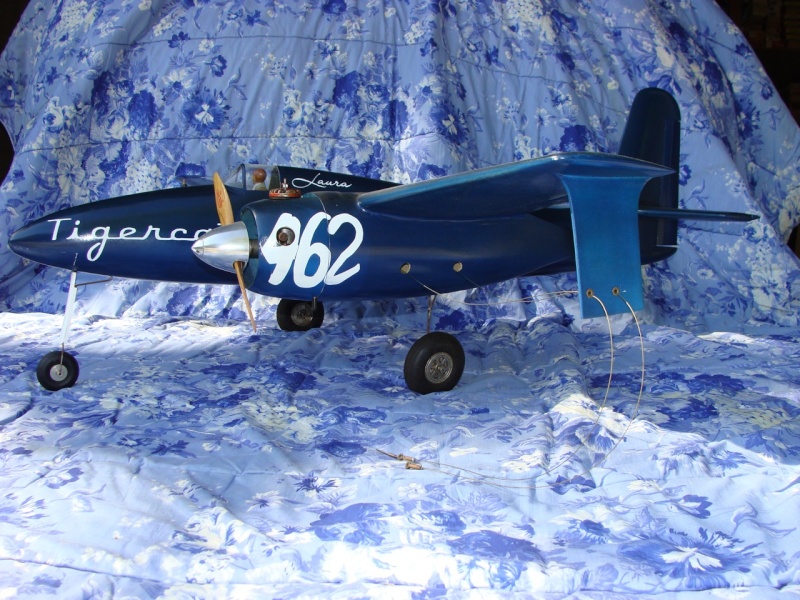
Here is a photo of my Tigercat leadouts. I just guessed at their proper height after considering the high winged model would need the leadouts low on the models total vertical mass. I installed the ply guide with a lot of area so I could move it. I was informed the model actually was rolled out a bit so raised them up and found the right height.
In the case of positive dihedral with leadouts internally, consider the mass of the model higher than the position of the leadouts at their exit, and that mass is balancing against the (very little) roll moment of the leadout to bellcrank misalignment. Raise and lower the leadout guide, even within the wingtip and see an attitude change while inflight. This is how it reacts in tethered flight like CL. Wingtip weight seems to be the same as a similar sized straight winged model.
I'm building a Top Flight Mustang with scale dihedral and will run the controls internally just as designed. I'll have photos and flying reports as soon as I fly it, but since it was designed by Stunt and Scale champion Jerry Worth and produced a few winning models by modelers all through the 60's, 70's and up until now, I'm figuring it'll be pretty close to right on with regard to wings level attitude. I believe the P-51 is just about right in this regard, and was the reason Al Rabe started his scale-like Stunters with that design. Check out his videos on You Tube to see them in action, nothing like a visual to help one figure it all out. It is with me, anyway.
Chris...
https://www.youtube.com/watch?v=RbzKY3Y3iLc


stuntflyr- Gold Member

- Posts : 266
Join date : 2012-01-18
Age : 65
Location : Tucson, Arizona
 Similar topics
Similar topics» The Cars are the Stars Contest.
» Was the Texan a great flier?
» Facebook, do you have a profile there?
» Profile F4 Phantom
» Landing gear kits for .049 now available
» Was the Texan a great flier?
» Facebook, do you have a profile there?
» Profile F4 Phantom
» Landing gear kits for .049 now available
Page 1 of 1
Permissions in this forum:
You cannot reply to topics in this forum

 Rules
Rules






